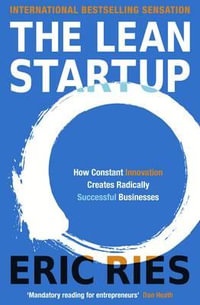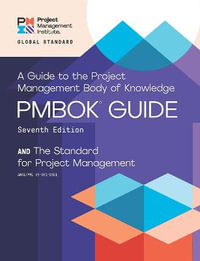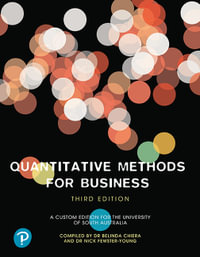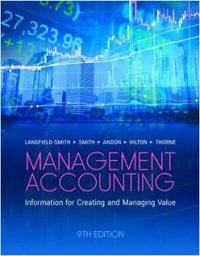
Corporate Financial Reporting and Analysis 4ed
A Global Perspective
By: S. David Young, Jacob Cohen, Daniel A. Bens
Paperback | 8 February 2019 | Edition Number 4
At a Glance
368 Pages
25.5 x 20.5 x 1.9
Paperback
RRP $111.95
$106.25
or 4 interest-free payments of $26.56 with
orAims to ship in 7 to 10 business days
Two decades of classroom testing among INSEAD MBA students has honed this text to provide the clearest, most comprehensive model for financial statement interpretation and analysis; a concise, logically organized pedagogical framework includes problems, discussion questions, and real-world case studies that illustrate applications and current practices, and in-depth examination of key topics clarifies complex concepts and builds professional intuition. With insightful coverage of revenue recognition, inventory accounting, receivables, long-term assets, M&A, income taxes, and other principle topics, this book provides both education and ongoing reference for MBA students.
About the Authors iv
1 An Introduction to Financial Statements 1
The Three Principal Financial Statements, 2
Other Items in the Annual Report, 9
Generally Accepted Accounting Principles: The Rules of the Game, 12
The Barriers to Understanding Financial Statements, 12
Key Lessons from the Chapter, 14
Key Terms and Concepts from the Chapter, 15
Questions, 15
Problems: 15
1.1 Balance Sheet Terminology, 15
1.2 Understanding Balance Sheet Relationships, 16
1.3 Interpreting an Auditor’s Opinion, 16
Case Studies: 17
1-1 Apple: An Introduction to Financial Statement Analysis, 17
1-2 Pepsico: Communicating Financial Performance, 20
Notes, 23
2 The Balance Sheet and Income Statement 24
A Further Look at the Balance Sheet, 24
Assets, 25
Liabilities, 27
Shareholders’ Equity, 28
A Further Look at the Income Statement, 29
Other Things You Should Know About the Balance Sheet and the Income Statement, 30
Key Lessons from the Chapter, 32
Key Terms and Concepts from the Chapter, 33
Questions, 33
Appendix 2.1 The Mechanics of Financial Accounting: The Double-Entry System, 33
Key Terms and Concepts from the Appendix, 42
Key Lessons from the Appendix, 42
Problem: 42
2.1 Preparing a Balance Sheet and an Income Statement, 42
Case Study: 43
2-1 JanMar Fabrics: Preparing the Balance Sheet and Income Statement, 43
3 A Brief Overview of GAAP and IFRS: The Framework for Financial Accounting 45
The Core Principles of GAAP and IFRS, 45
The Key Qualitative Characteristics of Financial Information, 47
The Key Assumptions of Financial Information, 48
Modifying Conventions, 48
The Future of Financial Reporting, 49
Key Lessons from the Chapter, 50
Key Terms and Concepts from the Chapter, 51
Questions, 51
4 Revenue Recognition 52
Introduction, 52
The Five-Step Revenue Recognition Model, 52
Revenue-Recognition Controversies, 65
Key Lessons from the Chapter, 68
Key Terms and Concepts from the Chapter, 68
Questions, 68
Problems: 68
4.1 Revenue Recognition at and After Time of Sale, 68
4.2 Recognizing Revenue Over Time, 69
4.3 Journal Entries for Gift Cards, 69
4.4 Recognizing Revenue Over Time, 69
4.5 Revenue Recognition in Different Types of Businesses, 69
Case Studies: 70
4-1 Kiwi Builders, Ltd., 70
4-2 Revenue Recognition at Starbucks Corporation, 70
4-3 Network Associates (McAfee): A Case of “Channel Stuffing”, 77
Notes, 79
5 The Statement of Cash Flows 80
Introduction, 80
The Reporting of Cash Flows from Operations, 80
Preparing the Statement of Cash Flows, 82
IFRS and the Statement of Cash Flows, 90
Analyzing the Statement of Cash Flows, 90
Key Lessons from the Chapter, 94
Key Terms and Concepts from the Chapter, 94
Questions, 95
Problems: 95
5.1 Interpreting the Statement of Cash Flows, 95
5.2 Adjustments on the Statement of Cash Flows, 95
5.3 Preparing and Analyzing a Statement of Cash Flows, 97
5.4 Interpreting the Role of Accounts Payable in Cash Flow from Operations, 97
5.5 Manipulating the Statement of Cash Flows, 98
5.6 Analysis of the Statement of Cash Flows, 98
5.7 Cash Flow and Credit Risk, 99
5.8 Preparing and Interpreting the Statement of Cash Flows, 100
Case Studies: 100
5-1 Blockbuster Inc.: Movie Rentals, Profits, and Operating Cash, 100
5-2 Monahan Manufacturing: Preparing and Interpreting a Statement of Cash Flows, 107
5-3 A Tale of Three Companies: Cash Flows at Sun Microsystems,Wal-Mart, and Merck, 108
5-4 Inditex: Analyzing the Statement of Cash Flows, 110
Notes, 114
6 Financial Statement Analysis 115
Introduction, 115
Business and Industry Analysis, 116
Accounting Analysis, 119
Financial Analysis, 119
Dupont Analysis, 122
ROE and the Analysis of Financial Risk, 129
Key Lessons from the Chapter, 136
Key Terms and Concepts from the Chapter, 137
Questions, 137
Appendix 6.1 An Industry and Competitive Analysis of Taiwan Semiconductor Manufacturing Company (TSMC), 137
Appendix 6.2 Summary of Financial Statement Ratios, 139
Problems: 141
6.1 Financial Statement Detective Exercise, 141
6.2 Effects of Transactions on Selected Balance Sheet Figures, 143
6.3 Calculating and Interpreting PP&E Turnover Ratios, 144
6.4 Financial Statement Detective Exercise in the Pharmaceutical Industry, 144
6.5 Comprehensive Financial Ratio Analysis, 146
6.6 Profitability Analysis for The Home Depot, 146
6.7 Comparative Analysis of Receivables and Inventories, 147
Case Studies: 147
6-1 Profitability Analysis and WalMart’s Suppliers, 147
6-2 LVMH and Warnaco: Strategy and Financial Statement Analysis, 148
Notes, 153
7 Business Valuation and Financial Statement Analysis 154
Valuation Principles, 154
Valuation: From Theory to Practice, 155
The Economic Profit Approach to Valuation, 156
A Case Study in Valuation: TSMC, 158
A Brief Word on Growth Rates, 162
Key Lessons from the Chapter, 165
Key Terms and Concepts from the Chapter, 165
Questions, 165
Problems: 165
7.1 Estimating the Value of The Home Depot, 165
7.2 Explaining Differences in P/E Ratios, 166
7.3 Explaining Differences in P/E Ratios, 166
Case Study: 166
7-1 Valuation Based on Discounted Cash Flows: The Case of Vardon Golf Ltd., 166
Notes, 167
8 Accounting for Receivables and Bad Debts 168
Introduction, 168
Estimating Bad Debts, 168
Writing off Accounts, 169
The Direct Method: An Alternative Approach, 169
What Happens When Written-off Accounts are Later Collected?, 170
The “Aging” of Accounts Receivable, 170
Sales Returns and Allowances, 171
Analyzing Receivables, 172
Key Lessons from the Chapter, 173
Key Terms and Concepts from the Chapter, 173
Questions, 173
Appendix 8.1 Accounting for Loan Loss Reserves, 173
Problems: 175
8.1 Bad Debts on Loans Receivable, 175
8.2 Determining Bad Debt Expense from an Aging Schedule, 175
8.3 Analyzing Receivables and the Allowance for Doubtful Accounts, 175
8.4 Provisions for Credit Losses, 181
Case Studies: 182
8-1 Receivables and Bad Debts at Toyota, 182
8-2 Johnson Perry, 182
8-3 Citigroup Inc.: Accounting for Loan Loss Reserves, 185
Notes, 191
9 Accounting for Inventory 192
Introduction, 192
Inventory Valuation: LIFO, FIFO, and the Rest, 195
The Lower of Cost or Net Realizable Value Rule, 196
The Cost-Flow Assumptions: An Example, 196
Inventory Cost-Flow Assumptions: A Summary, 199
Key Lessons from the Chapter, 200
Key Terms and Concepts from the Chapter, 200
Questions, 200
Problems: 201
9.1 Calculating Inventory Under the FIFO and Average-Cost Methods, 201
9.2 Inventories and Ratio Analysis, 201
9.3 Correcting Inventory Errors, 201
9.4 The Lower of Cost or Net Realizable Value Rule, 201
9.5 Calculating Cost of Goods Sold Under FIFO and Specific Identification, 201
Case Studies: 202
9-1 LIFO Accounting at Tamar Chemicals, 202
9-2 Deere and CNH Global: Performance Effects of Inventory Accounting Choice, 202
Notes, 208
10 Accounting for Property, Plant, and Equipment 209
Introduction, 209
Initial Recognition of PP&E, 210
Subsequent Expenditures: Repair or Improvement?, 211
Accounting for Depreciation, 211
Changes in Depreciation Estimates or Methods, 213
Asset Impairment, 214
Fair Value vs. Historical Cost, 215
Divestitures and Asset Sales, 216
Intangible Assets, 216
Key Lessons from the Chapter, 218
Key Terms and Concepts from the Chapter, 218
Questions, 218
Problems: 219
10.1 Comparing the Effects of Depreciation Choice on Financial Ratios, 219
10.2 Analyzing Depreciation on PP&E, 219
10.3 Calculating and Analyzing Amortization Expense, 220
10.4 Calculating Depreciation Expense, 220
10.5 Effects of Changes in Estimates on Depreciation Expense, 221
10.6 Interpreting Disclosures for Property, Plant and Equipment, 221
10.7 Capitalizing or Expensing Costs, 224
10.8 Journal Entries for Depreciation and Amortization Expense, 224
11 Leases and Off-Balance-Sheet Debt 225
Introduction, 225
Leasing Accounting Before 2018: Capital vs. Operating Leases, 225
Accounting for Capital Leases, 226
Accounting for Operating Leases, 227
Lease Accounting: An Example, 227
Interpreting Lease Disclosures, 229
Off-Balance-Sheet Debt, 230
Recent Developments in Lease Accounting, 231
Key Lessons from the Chapter, 233
Key Terms and Concepts from the Chapter, 233
Questions, 233
Problem: 233
11.1 The Financial Reporting Effects of Selling Receivables, 233
Case Studies: 234
11-1 Lease Accounting at Metro AG, 234
11-2 Pennzoil-Quaker State and the Sale of Receivables, 235
11-3 Executory Contracts, 235
Note, 235
12 Accounting for Bonds 236
Introduction, 236
Accounting for Bond Issuance, 237
Accounting for Bonds Sold at Par, 238
Accounting for Bonds Sold at a Premium, 238
Bond Redemption Before Maturity, 242
Accounting for Bonds Issued at a Discount, 242
Zero-Coupon Bonds, 244
Key Lessons from the Chapter, 246
Key Terms and Concepts from the Chapter, 246
Questions, 247
Problems: 247
12.1 Journal Entries and Balance Sheet Presentation for Bonds, 247
12.2 Amortization of Bond Discount and Premium, 247
12.3 Journal Entries for Bond Issuance and Subsequent Interest Payments, 247
13 Provisions and Contingencies 248
Introduction, 248
Defining Provisions, 249
Measuring the Provision, 249
Disclosure of Provisions: Interpreting the Notes, 250
Contingent Liabilities, 251
Contingent Assets, 254
Key Lessons from the Chapter, 254
Key Terms and Concepts from the Chapter, 254
Questions, 254
Problems: 255
13.1 Accounting for Warranties, 255
13.2 Analyzing and Interpreting Disclosures on the Provision for Warranties, 255
Case Studies: 255
13-1 Accounting for Contingent Assets: The Case of Cardinal Health, 255
13-2 Firestone Tire and Rubber Company (A), 257
13-3 Firestone Tire and Rubber Company (B), 259
Notes, 259
14 Accounting for Pensions 260
Introduction, 260
A Brief Word on Defined Contribution Plans, 260
Unfunded Defined Benefit Plans, 261
Funded Defined Benefit Plans, 261
American Airlines: An Example of Defined Benefit Plan Disclosure, 267
Key Lessons from the Chapter, 269
Key Terms and Concepts from the Chapter, 270
Questions, 270
Case Study: 270
14-1 Comprehensive Pension Review Problem: Cathay Pacific, 270
Note, 273
15 Accounting for Income Tax 274
Introduction, 274
Temporary and Permanent Differences, 275
Deferred Taxes and the Balance Sheet Approach, 276
The Balance Sheet Approach: An Example, 277
Interpreting Income Tax Disclosures: The Case of Intel Corporation, 279
Why Deferred Income Tax is Important, 284
Key Lessons from the Chapter, 285
Key Terms and Concepts from the Chapter, 285
Questions, 285
Problems: 285
15.1 Calculating Temporary and Permanent Differences, 285
15.2 Interpreting Income Tax Disclosures, 286
15.3 Deferred Income Taxes and the Statement of Cash Flows, 286
Case Study: 288
15-1 Deferred Tax Assets and the Valuation Allowance: The Case of Ford Motor Company, 288
Notes, 292
16 Accounting for Shareholders’ Equity 293
Introduction, 293
Shareholders’ Equity: An Introduction, 293
More on Contributed Capital, 297
Accounting for Stock Transactions, 298
Dividends on Common Stock, 301
Stock Dividends and Stock Splits, 303
Accumulated Other Comprehensive Income, 305
Convertible Bonds, 305
The Statement of Shareholders’ Equity, 307
Key Lessons from the Chapter, 308
Key Terms and Concepts from the Chapter, 308
Questions, 308
Problems: 309
16.1 Effect of Selected Transactions on Net Income and Shareholders’ Equity, 309
16.2 Share Buybacks, 309
16.3 The Financial Statement Effects of Dividend Payments and Buybacks, 309
16.4 The Accounting and Economic Consequences of Stock Splits and Stock Dividends, 310
Case Studies: 310
16-1 Stock Options, Stock Dividends, and Stock Splits, 310
16-2 Share Buybacks: Economic Rationale and Financial Reporting Effects, 311
16-3 The Accounting for Convertible Bonds, 311
16-4 Why Do Companies Buy Back Their Own Shares? The Case of the Scomi Group, 311
Notes, 312
17 Investments 313
Introduction, 313
Investments at Microsoft, 313
Debt and Passive Equity Investments, 314
The Fair Value Hierarchy, 316
Equity Method, 317
A Further Look at Microsoft’s Investments, 319
Consolidation, 321
Key Lessons from the Chapter, 323
Key Terms and Concepts from the Chapter, 324
Questions, 324
Problems: 324
17.1 Classification of Long-Term Investments, 324
17.2 The Effect of Transaction Cost on Marketable Securities and Investments, 325
17.3 Journal Entries and Analysis Under the Equity Method, 325
17.4 Review Problem, 325
17.5 Mark-to-Market Accounting for Trading Securities, 326
17.6 The Equity Method and the Statement of Cash Flows, 326
Case Studies: 327
17-1 Stora Enso: Accounting for Investments, 327
17-2 Coca-Cola and Coca-Cola Enterprises: The Equity
Method in Practice, 328
Notes, 328
18 Accounting for Mergers and Acquisitions 329
Introduction, 329
Purchase Price/Cost of Acquisition, 329
Contingent Consideration, 330
Recognition and Measurement of Identifiable Assets, 330
Subsequent Adjustments to Acquired Assets and Liabilities, 334
Goodwill Impairment, 334
Noncontrolling Interest, 335
Key Lessons from the Chapter, 336
Key Terms and Concepts from the Chapter, 336
Questions, 336
Problems: 336
18.1 Journal Entry for an Acquisition, 336
18.2 Analysis of an Acquisition, 337
18.3 Accounting for an Acquisition: Carrefour and BLC (China), 337
18.4 Business Combinations at Tesco, 338
18.5 AB InBev acquires SABMiller, 338
Appendix: Tables for Present Value and Future Value Factors 342
Index 351
ISBN: 9781119494577
ISBN-10: 1119494575
Published: 8th February 2019
Format: Paperback
Language: English
Number of Pages: 368
Audience: College, Tertiary and University
Publisher: John Wiley & Sons (UK)
Country of Publication: GB
Edition Number: 4
Dimensions (cm): 25.5 x 20.5 x 1.9
Weight (kg): 0.71
Shipping
| Standard Shipping | Express Shipping | |
|---|---|---|
| Metro postcodes: | $9.99 | $14.95 |
| Regional postcodes: | $9.99 | $14.95 |
| Rural postcodes: | $9.99 | $14.95 |
How to return your order
At Booktopia, we offer hassle-free returns in accordance with our returns policy. If you wish to return an item, please get in touch with Booktopia Customer Care.
Additional postage charges may be applicable.
Defective items
If there is a problem with any of the items received for your order then the Booktopia Customer Care team is ready to assist you.
For more info please visit our Help Centre.
You Can Find This Book In

Blue Ocean Strategy, Expanded Edition
How to Create Uncontested Market Space and Make the Competition Irrelevant
Hardcover
RRP $54.99
$38.35
OFF






















